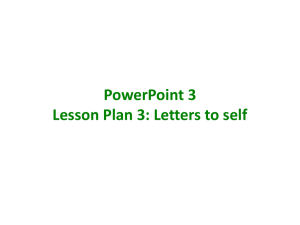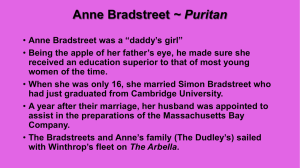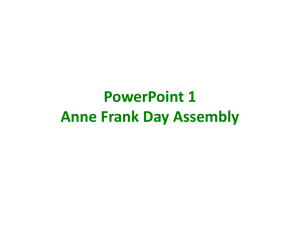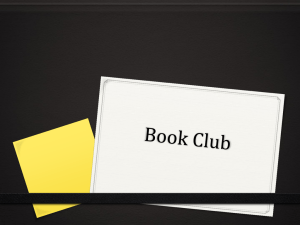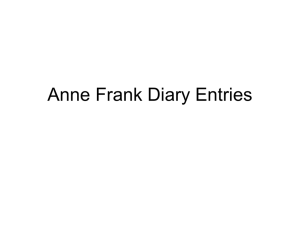PowerPoint - Carolina Curriculum
advertisement
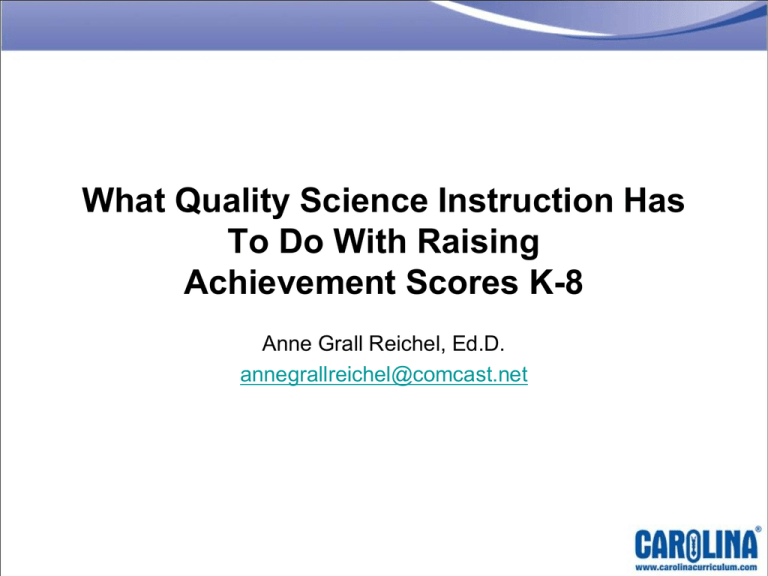
What Quality Science Instruction Has To Do With Raising Achievement Scores K-8 Anne Grall Reichel, Ed.D. annegrallreichel@comcast.net Session Goals • To explore the relationship between inquiry-based science instruction and the integration of reading and writing on student achievement. • To gain practical strategies that you can use to readily advocate for quality science instruction in your district. Anne Grall Reichel, Ed.D The Imperative “We in this country, stand at the intersection… of educational history. The field of American education is changing in ways that are more dramatic and far-reaching than anything any of us could have imagined. If we are going to take a role in shaping the future, then we need to see hope and opportunity….We need to see what is good about the Common Core Standards and roll up our sleeves and work to make those standards into a force that lifts our teaching and our schools.” Pathways to the Common Core Calkins, Ehrenworth & Lehman Anne Grall Reichel, Ed.D The Essential Question So what does quality science instruction have to do with raising achievement scores K-8? Anne Grall Reichel, Ed.D EVERYTHING!!!! Anne Grall Reichel, Ed.D How do you define “quality” science instruction? Anne Grall Reichel, Ed.D Quality Science Instruction • Practices of Science • Engaging in argumentation from evidence • Obtaining, evaluating and communicating information • Cross Cutting Concepts • Making connections • Core Disciplinary Ideas • Thinking deeply and critically • Applying concepts in new contexts Anne Grall Reichel, Ed.D Success Stories • Oak Lawn School District (49% free and reduced lunch) • Before we logically integrated common core reading and writing prompts with science and social studies – 2 schools met AYP • After integration – 6 of 7 schools made AYP one year after implementation Anne Grall Reichel, Ed.D Success Stories • Wilmette District 39 • Claims/Evidence Charts • Differentiated Informational Text • Reader Responses Connected to Common Core Reading Standards for Informational Text • Summative Assessment Writing Prompts in Science • Student Notebooks • Teacher Training on the Integrated Approach & Science Content Anne Grall Reichel, Ed.D Success Stories Wilmette 39: Inquiry Scores on State Science Test % with 12 or more correct % with 13 or more correct % with 15 correct 2011 60 45 6 2012 70 58 12 Anne Grall Reichel, Ed.D Reeves 90/90/90 Study • Writing and reading in the informational genre makes a difference in student achievement Anne Grall Reichel, Ed.D Practical Strategies: Become An Advocate for Science Emphasize: • Writing as a way of processing information in science • Writing as a way of thinking • Writing to argue: “The argument writing standard ask that students are able to support their claims in an analysis of substantive topics or texts and those claims are strengthened by valid reasoning and relevant and sufficient evidence.” (Calkins, Ehrenworth & Lehman, 2012) Anne Grall Reichel, Ed.D Construct an Understanding of the Nature of Science “Science is a body of knowledge rooted in evidence” (A Framework for k-12 Science Education, p.26) • • • • Create a classroom community where students engage in argumentation Help students learn how to analyze data to find evidence to support their claims. Use claim and evidence charts in the classroom. (Example to follow)) Use ICE charts in students notebooks. (Example to follow) Anne Grall Reichel, Ed.D Sample “Claim & Evidence” Chart CLAIM EVIDENCE Annual patterns of living organisms are changing • butterfly migration patterns • bird migration patterns • budding trees Anne Grall Reichel, Ed.D Use ICE Charts To Focus Writing in Student Notebooks Support the writing process in notebooks by using an ICE chart. – – – Ideas Claims Evidence When salt dissolves in water it disappears. Salt does not disappear when it dissolves. When we evaporated the salt water there was salt in the dry petri dish. Ideas Claims Evidence Anne Grall Reichel, Ed.D Practice: What claim can you make about the relationship between force and the speed of the vehicle? Claim Number of washers used to increase pull force Speed Ranking (1-5) 1=slowest 5=fastest 1 washer 1 2 washers 2 3 washers 3 4 washers 4 5 washers 5 Anne Grall Reichel, Ed.D Practice: Can you find evidence to support or negate the following claim? (Lesson 4 – Motion & Design) CLAIM: The larger the load, the more slowly the vehicle speeds up when a constant force is applied. Anne Grall Reichel, Ed.D Evidence Use the reciprocal process of building claims and evidence to move towards writing arguments Sample Anchor Chart From The Common Core Toolkit I developed a claim based upon the evidence I gathered. • I stated my “claim”. • I created an organized way of sharing my “claim” and “evidence” with my reader. • I provided “evidence” from my data, conversations with other scientists, and my research. • I linked my ideas together with words. (e.g. consequently, generally, specifically) • I kept my reader interested and used persuasive language in my writing. • I organized my thinking in a concluding sentence that restates my main idea. Anne Grall Reichel, Ed.D Use Writing Prompts to Integrate Informational Text and Science Prompt: After reading What’s the Best Blub? Make a recommendation on which type of light bulb to purchase. Support your recommendation with evidence from the text. CLAIM EVIDENCE I recommend….. Because…… Anne Grall Reichel, Ed.D Sample Expository Writing Prompts • • • • • How to wire a four room box How to plant a Wisconsin Fast Plant How to read a technical drawing How to build a scale model How to test soil samples for their capacity to retain water • Explain the effects of slope on stream formation. Anne Grall Reichel, Ed.D Sample Narrative Prompts • Prompt: Write a narrative from the perspective of Edison as he struggled to find the ideal filament for a light bulb. • Prompt: Write a narrative as a Wright Brother or as one of the pioneer female pilots, tell about your thought process and or motivation to fly. Anne Grall Reichel, Ed.D Sample Prompts: Write to Argue Prompt: A friend has the misconception that our supply of water is unlimited. Convince your friend that it is important to conserve water. Support your position with evidence from your readings and research. Prompt: After creating a cost efficient vehicle design, develop an advertising campaign for your design. Support with evidence from the data you collected on the efficiency of your vehicle. Prompt: Argue the placement of an element on the periodic table based upon the element’s properties. Anne Grall Reichel, Ed.D Practical Strategies: Become An Advocate for Science Explain that literacy plays a critical role in all disciplines including science, social studies, and mathematics. Use a calendar approach where expository, narrative, and argumentative writing spiral three times throughout the year. Anne Grall Reichel, Ed.D Sample Spiraling Cycle Month Type of Writing September Narrative October Expository November Argument December Narrative January Expository February Argument March Narrative April Expository May Argument Anne Grall Reichel, Ed.D Practical Strategies: Teach Graph as Story After collecting and graphing data challenge students to: • Develop the best TITLE for the graph • Develop a CAPTION for the graph • Develop a Story with key details from the graph Anne Grall Reichel, Ed.D Write a Caption for the Graph Anne Grall Reichel, Ed.D Practical Strategies: Align the Reading Informational Text Standards in the Common Core to the informational text used at each grade level. The Reading Informational Standards are listed in your Common Core Toolkit Anne Grall Reichel, Ed.D Common Core Grade 4 Reading Informational Text Common Core Grade Four Alignment to STC Informational Text RI 1. Refer to details and examples in a text when explaining what the text says explicitly and when drawing inferences from the text. RI 1. After reading From Batteries to Power Grids: Thomas Edison Paves The Way students explain key concepts explicitly referring to the text and draw inferences about Edison citing textual evidence. STC Reader pages 17-21 RI 2. Determine the main idea of a text and explain how it is supported by key details; summarize the text. RI 2. Students determine the main idea: (Edison was hard working and inquisitive as a child.) Students find textual evidence to support the main idea. Kids Discover: Thomas Edison pages 6-7 Anne Grall Reichel, Ed.D Common Core Grade 4 Reading Informational Text Common Core Grade Four Alignment to STC Informational Text RI 3. Explain events, procedures, ideas, or concepts in a historical, scientific, or technical text, including what happened and why, based on specific information in the text. RI 3. Analyze the story Where Does Electricity Come From and identify key words that let the reader know they are reading a sequence. (Examples: begins, next, now) Students explain how each step in the sequence leads to the next. STC Reader Pages 24-26 RI 4. Determine the meaning of general academic and domain-specific words or phrases in a text relevant to a grade 4 topic or subject area RI.4 Students determine the meaning of domain-specific words or phrases, such as conductor/insulator. They gain greater understanding of the words through investigation (Lesson 7). They use glossaries to clarify meaning and find applications of the words in the STC Reader gaining additional understanding from context clues Anne Grall Reichel, Ed.D Common Core Grade 4 Reading Informational Text Common Core Grade Four Alignment to STC Informational Text RI 5. Describe the overall structure (e.g., chronology, comparison, cause/effect, problem/solution) of events, ideas, concepts, or information in a text or part of a text. RI 5. Students analyze From Batteries To Power Grids: Thomas Edison Paves the Way. They analyze the text and determine that the overall structure is problem and solution. They identify the problems Edison encountered and describe his solutions. STC Reader Electric Circuits (pages 17-19) RI 6. Compare and contrast a firsthand and secondhand account of the same event or topic; describe the differences in focus and the information provided. RI 6. Students compare and contrast Galvani’s firsthand account with the secondhand account in Luigi Galvani and the Frog That Kicked. They describe the differences in focus of the information provided in the first and second hand account. Students explain how both accounts contribute to their understanding. Reference STC Reader Electric Circuits (pages 11-12) Anne Grall Reichel, Ed.D Common Core Grade 4 Reading Informational Text Common Core Grade Four Alignment to STC Informational Text RI 7. Interpret information presented RI 7. Students read a meter and visually, orally, or quantitatively (e.g., in charts, graphs, diagrams, time lines, animations, or interactive elements on Web pages) and explain how the information contributes to an understanding of the text in which it appears. interpret the information to see if an electric bill represented the actual kilowatt hours accurately. Reference: STC Reader: Electric Circuits “Electric Meter Mystery” (p.35) Anne Grall Reichel, Ed.D Integration When and Where should I integrate reading & writing in science instruction? Think about the integrated vignette as I describe the placement of reading and writing and vocabulary development in science instruction. Anne Grall Reichel, Ed.D The Integrated Vignette FOCUS • Start by introducing the engineering challenge. • Pre-assess. EXPLORE • Construct understanding experientially. Note: vocabulary is introduced by function before domain- specific words are applied. • Results are recorded in journals. • Domain-specific words are applied to categories (conductors/insulators). REFLECT • Look for multiple definitions of the words. • Use Glossary: Evaluate which definition applies to science. • Students create own definitions for domainspecific words and record them in journals. • Read about Edison’s challenge to find a conductor for the filament in a working electric bulb. • Reflect upon Edison’s perseverance and resilience in journals. Support journal entry with textual evidence. APPLY • Students apply their understanding of conductors and insulators to the engineering challenge. • Expository: “How To Wire A Four Room Box” Anne Grall Reichel, Ed.D


